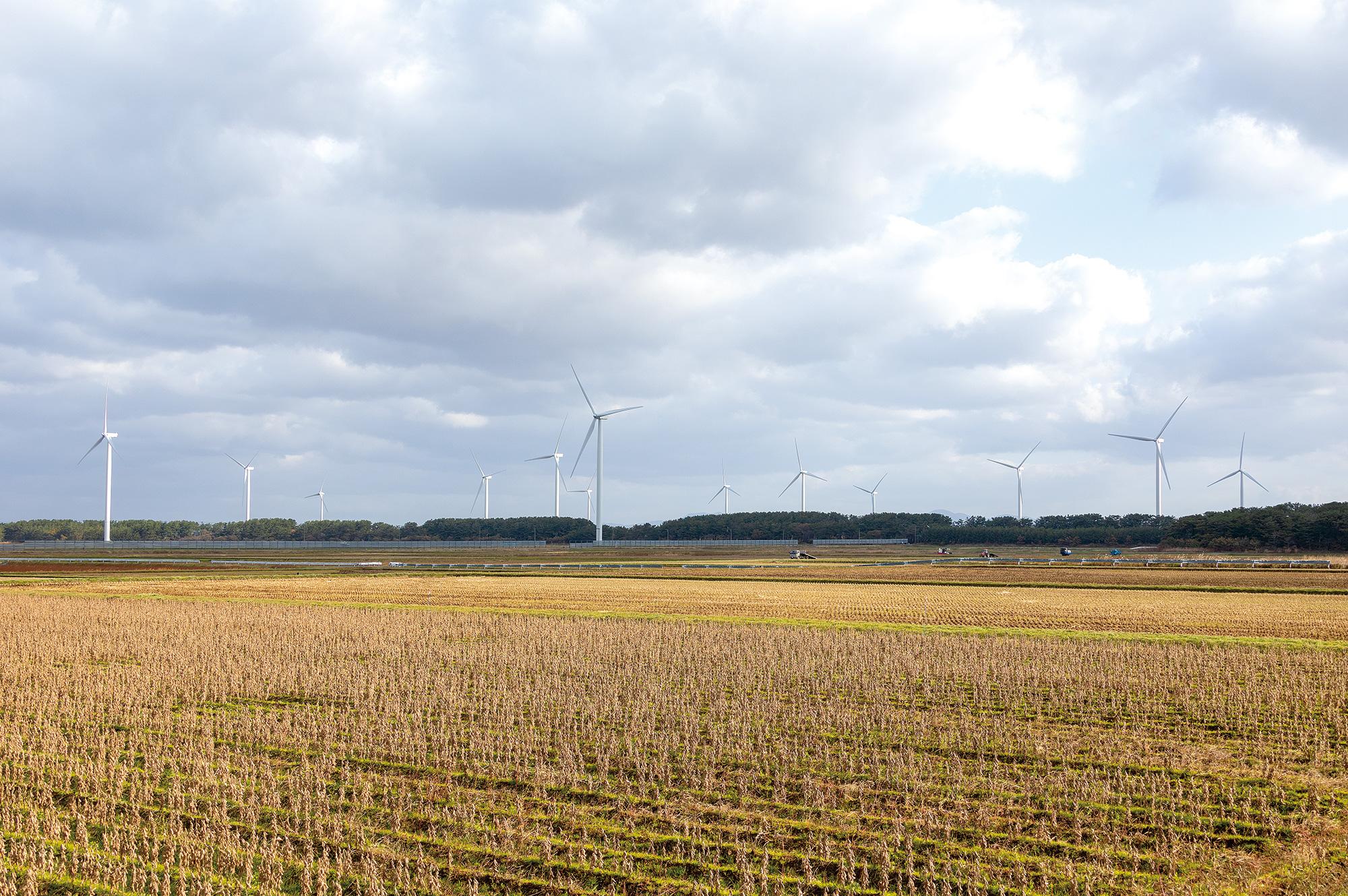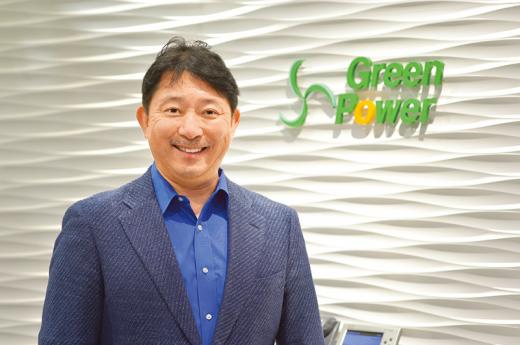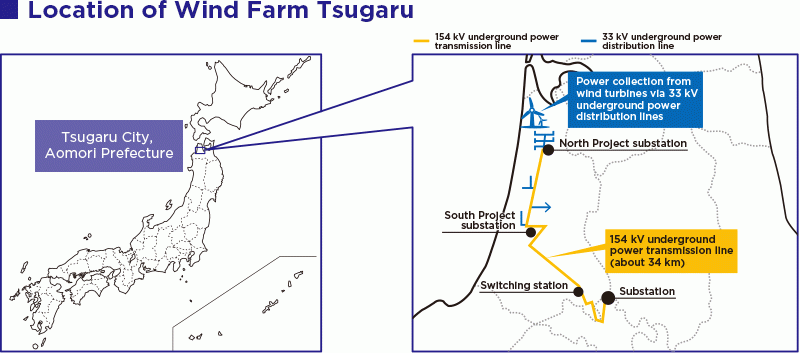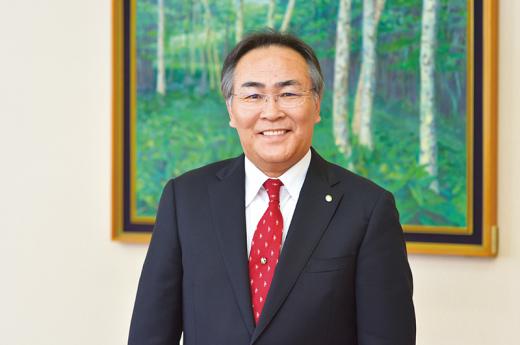
Significance of the Largest Onshore Wind Farm in Japan
Tsugaru City, where wind conditions are among the best in Japan
Tsugaru City is situated in the northwestern part of Aomori Prefecture. Facing the Sea of Japan, the city is located on the vast Tsugaru Plain, which forms one of the largest granaries in Japan. The annual mean wind speed is over 7.0 m/sec. in the coastal area of the Sea of Japan, from the western part of Aomori Prefecture, including Tsugaru City, to Akita Prefecture in the south and Hokkaido in the north. This area is considered to be suitable for wind power generation. Here, the Wind Farm Tsugaru Wind Power Generation Project (name of the power plant: Wind Farm Tsugaru) is in operation. In the vast area along the area-wide agricultural road named the Melon Road (stretching about 10 km from north to south) in Tsugaru City, as many as 38 wind turbines in total (21 in the North Site, five in the Center Site, and 12 in the South Site) are in place. The scale is the largest in Japan. Commercial operation started in April 2020.
The project started more than 10 years ago. At that time, Japan was on the threshold of introducing renewable energy on a large scale. Green Power Investment Corporation (GPI) approached Tsugaru City because GPI recognized the city’s future potential. Founded in 2004, GPI has consistently promoted the development, construction and operation of the renewable energy business. As a pioneer, it has made efforts to develop Japan’s renewable energy industry. It has deployed renewable energy projects at eight locations across Japan, including projects for which construction is about to commence. Many new projects are being planned. Yoshiyuki Mitsuhashi, Senior Managing Director and Deputy Head of Business Development of GPI, explained why the company focused on Tsugaru City.

“For a business operator engaged in the development of wind power generation projects, wind is the biggest factor for success. Feasibility depends largely on the strength of the wind that produces the electricity. In this context, many business operators, including GPI, pay attention to the coastal areas in Aomori, Akita and Hokkaido on the Sea of Japan because these areas meet all the requirements for good wind conditions, including the strength, direction and quality of the wind. Notably, the wind conditions in Tsugaru City are among the best in Japan. Many renewable energy companies have showed interest in launching wind power generation projects,” said Mitsuhashi.
Largest onshore wind farm in Japan using 38 wind turbines with a total output of 121,600 kW
A wind power generation project starts with checking the wind conditions, securing the site and acquiring the right to connect a power transmission line to the grid (grid connection). To deliver electricity derived from wind power generation, it is necessary to transmit electricity by using the grid established by an electric power company. Wind power generation is unfeasible as a business without acquiring this right. Various methods have been used in the past to determine who would acquire this right. The winner of the Tsugaru right was selected by lottery. It was decided that GPI, which won the lottery, would promote the wind power generation project in Tsugaru City. GPI’s plan was to construct the largest onshore wind farm in Japan using 38 wind turbines with a total output of 121,600 kW (about 120 MW), equivalent to the amount of electricity needed to power about 90,000 households. GPI acquired the grid connection right from an electric power company in 2011 when the Great East Japan Earthquake developed momentum toward introducing and using renewable energy. The feed-in tariff (FIT) program, which started in July 2012, spurred the introduction and use of renewable energy in Japan.

Placing priority on communication and collaboration with local communities
When the project was launched, it was not permitted to use farmland for other business purposes from the viewpoint of ensuring the food supply and national land conservation. However, Tsugaru City and renewable energy companies, including GPI, never gave up and continued to persuade the national government to change its position. Three years after acquiring the right to use the power transmission line, the national government acknowledged the contribution of renewable energy to farming, mountain and fishing villages. Finally, the Act on Promoting the Generation of Electricity from Renewable Energy Sources Harmonized with Sound Development of Agriculture, Forestry and Fisheries was enacted, opening the way for conversion of farmland. The act aims to create a mechanism for revitalizing farming, mountain and fishing villages by using local resources for the renewable energy business and using the profits, which are derived from selling electricity, for local communities while ensuring harmony with farming, forestry and fishery.
Mitsuhashi said, “Enactment of this law prompted the full launch of the project. Notably, we placed top priority on gaining the understanding of local residents. Thus, we focused on communication and collaboration with local communities. We have abided by the policy of promoting the project with Tsugaru City—not treating it as a GPI project only—from the kickoff, to the commencement of power generation, and to the current operation phase.”
In response to GPI’s commitment, Tsugaru City took an important step. In 2016, the city formulated the Tsugaru City Renewable Energy Basic Plan, which laid the foundation to effectively use wind, a local resource that had remained untapped, revitalize local communities, and pursue both self-reliant development and use of renewable energy. Hiroaki Kuramitsu, who was the chairperson of the then newly established Tsugaru City Council for Revitalization of Farming, Mountain and Fishing Villages Through Promotion of the Use of Renewable Energy and currently serves as the city’s mayor, expressed his expectations for the wind power generation project.

“The wind farm is expected to create jobs and increase tax revenue. In addition, GPI’s project was highly advantageous for Tsugaru City, such as in the promotion of primary industry through original community benefit program paid from the profits. The most important part of implementing the project is coordination with residents. GPI undertook the entire process of obtaining consent from local residents toward the commencement of construction of the wind farm, such as gaining understanding about the project from landowners in the area where wind turbines were to be installed and requesting landowners to lease their land. After seeing GPI’s community-based efforts to prepare for the commencement of construction,
we judged that GPI was a trustworthy business operator. As a local government, we set up a council and held consultations with the national authorities toward the conversion of farmland. Efforts have been made in various parts of Japan to introduce renewable energy. It is important to ascertain whether it is worth working with a business operator for 20 years, which is a long period,” said Kuramitsu.
GPI made preparations steadily toward construction of a power plant.

NEXT
Solving an Unprecedented Problem of Long-Distance Cables
— Strength and synergies demonstrated by the Sumitomo Electric Group —
Registration of public notification
If you register your e-mail address, we will notify you when the latest issue is published. If you wish, please register from the registration form.
To delete your registration, please visit here.
